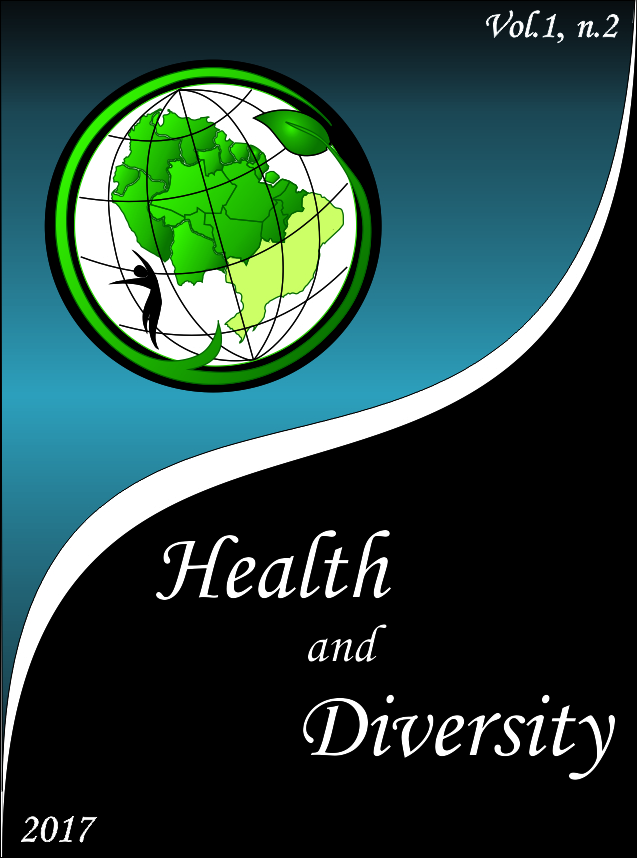Epidemiological characterization of malaria in Roraima from 2006 to 2016
DOI:
https://doi.org/10.18227/hd.v1i2.7477Keywords:
Malaria, Plasmodium, parasitoses, diseaseAbstract
Introduction: Malaria is one of the most known and ancient human parasites. It is an infectious disease with episodic manifestations of acute character. Its vector are females of the genus Anopheles. It has as protozoan etiological agents belonging to the Family Plasmodiidae, of the genus Plasmodium and of the most diverse species only P. vivax, P. falciparum, P. malariae and P. ovale are responsible for this pathology. Malaria is an endemic in the Brazilian Amazon, distributed among the states of Acre, Amazonas, Amapá, Pará, Rondônia, Roraima, Tocantins, Mato Grosso and Maranhão. Objective: The aim of this study was to describe the epidemiology of malaria in the last 10 years. Methods: For the development of this research, data were collected from the Malaria Information System and Information System for Malaria Epidemiological Surveillance, comprising the years 2006 to 2016. Based on the reports, data were analyzed regarding the number of positive cases in this period, case distribution by Plasmodium specimen and Annual Parasite Index (IPA) values. These data were expressed and distributed in order to understand the epidemiological course of malaria over the 10 years observed. Results: During this period, 138,644 cases of malaria were registered throughout the State of Roraima, 83.36% were confirmed for P. vivax, 15.52% for P. falciparum and 1.12% of cases were mixed malaria. Conclusion: The need for studies related to the epidemiological profile of malaria in the State of Roraima is evident.
Downloads
References
BRASIL. Manual de diagnóstico laboratorial da malária. Brasília: Ministério da Saúde: 116 p. 2009.
CIMERMAN, B.; CIMERMAN, S. Parasitologia Humana e seus fundamentos gerais. 2. São Paulo: Atheneu, 2002.
CONSOLI, R. A. G. B.; OLIVEIRA, R. L. Principais mosquitos de importância sanitária no Brasil. Rio deJaneiro: Fiocruz, 1998. Coordenação de Vigilância em Saúde de Roraima. Controle de Malária.
DE BARROS, F. S. M.; HONORIO, N. A.; ARRUDA, M. E. Survivorship of Anopheles darlingi (Diptera: Culicidae) in Relation with Malaria Incidence in the Brazilian Amazon. Plos One, v. 6, n. 8, Aug 8 2011.
JACKSON, M. C.; JOHANSEN, L.; FURLONG, C.; COLSON, A.; SELLERS, K. F. Modelling the effect of climate change on prevalence of malaria in western Africa. Statistica Neerlandica,v. 64, n. 4, p. 388-400, Nov 2010.
INSTITUTO BRASILEIRO DE GEOGRAFIA E ESTATÍSTICA, Situação Demográfica. Resumo Nacional, 1920-70.
MACHADO, R. L. D.; COUTO, A. A. R. A.; CAVASINI, C. E.; CALVOSA, V. S. P. Malária em região extra-Amazônica: situação no Estado de Santa Catarina. Revista da Sociedade Brasileira de Medicina Tropical, v. 36, n. 5, p. 581-586, 2003.
HERMES; M. N. C. S. NUNES, B. L. V. DORVAL; C. L. M. BRILHANTE; F. A. ASPECTOS EPIDEMIOLÓGICOS DA MALÁRIA HUMANA NO MUNICÍPIO DE ARIPUANÃ, ESTADO DE MATO GROSSO, BRASIL, 2005 A 2010. Revista Brasileira de Geografia Médica e da Saúde. Disponível em: < www.seer.ufu.br/index.php/hygeia/article/download/22717/13621>. Acesso em: 19 mai. 2017.
SANTELLI, A. C. F. e S. et al Plano de eliminação de malária no Brasil Fase 1 Malária falciparum. 2016. Disponível em: < http://portalarquivos.saude.gov.br/images/pdf/2017/janeiro/04/Plano-eliminacao -malaria-pub.pdf>. Acesso em: 19 abr. 2017.
NEVES, D. P. Parasitologia Humana. 13 ed. Coleção Biblioteca biomédica. São Paulo: Atheneu, 2016.
PARHAM, P. E.; MICHAEL, E. Modeling the Effects of Weather and Climate Change on Malaria Transmission. EnvironmentalHealth Perspectives, v. 118, n. 5, p. 620- 626, May 2010.
REY, L. Bases da Parasitologia Médica. 2. ed. Rio de Janeiro: Guanabara Koogan, 2002.
JOSELI OLIVEIRA-FERREIRA; MARCUS VG LACERDA; PATRÍCIA BRASIL; JOSÉ LB LADISLAU; PEDRO L TAUIL; CLÁUDIO TADEU DANIELRIBEIRO. Malaria in Brazil: an overview. BiomedCentral. 2010. Disponível em: < https://malariajournal.biomedcentral.com/articles/10.1186/1475-2875-9-115>. Acesso em: 17 mai. 2017.
PATZ, J. A.; CAMPBELL-LENDRUM, D.; HOLLOWAY, T.; FOLEY, J. A. Impact of regional climate change on human health. Nature. 2005.
REINERS, A.A.O.; AZEVEDO, R.C.S.; RICCI, H.A.; SOUZA, T.G. Adesão e reação de usuários ao tratamento da malária: implicações para a educação em saúde. Texto & Contexto Enferm. 2010. Disponível em: <http://www.scielo.br/pdf/tce/v19n3/a16v19n3.pdf>. Acesso em: 19 mai. 2017.
SANTELLI, A. C. F. e S. et al Plano de eliminação de malária no Brasil Fase 1 Malária falciparum. 2016. Disponível em: < http://portalarquivos.saude.gov.br/images/pdf/2017/janeiro/04/Plano-eliminacao -malaria-pub.pdf>. Acesso em: 19 abr. 2017.
WHO. World Malaria Report 2016. Disponível em: <http://www.who.int/malaria/publications/world-malariareport-2016/report/en/> Acesso em: 20 jun. 2017.
STEFANI, A.; DUSFOUR, I.; CRUZ, M. C. B.; DESSAY, N.; GALARDO, A. K. R.; GALARDO, C. D.; GIROD, R.; GOMES, M. S. M.; GURGEL, H.; LIMA, A. C. F.; MORENO, E. S.; MUSSET, L.; NACHER, M.; SOARES, A. C. S.; CARME, B.; ROUX, E. Land cover, land use and malaria in the Amazon: a systematic literature review of studies using remotely sensed data. Malaria journal, v. 12, Jun 8 2013.
TAIUL, P.L. Ministério da Saúde. 8 Malária no Brasil: Epidemiologia e controle. Brasília - DF p. 5, 2009. Disponível em: <http://portalsaude.saude.gov.br/portalsaude/arquivos/saudebrasil2009_parte2_cap8.pdf>. Acesso em 15 dez. 2013.
VERONESI, R.; FOCACCIA, R. Tratado de infectologia. São Paulo: Atheneu, 1996.
Downloads
Published
How to Cite
Issue
Section
License

This work is licensed under a Creative Commons Attribution-NonCommercial-NoDerivatives 4.0 International License.

Este obra está licenciado com uma Licença Creative Commons Atribuição 4.0 Internacional.







